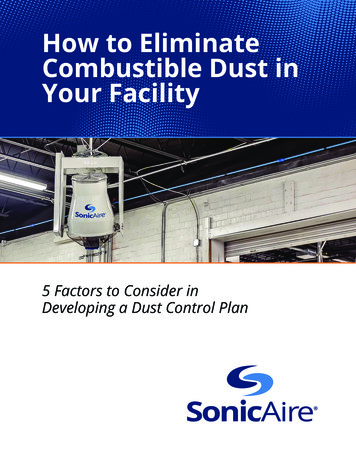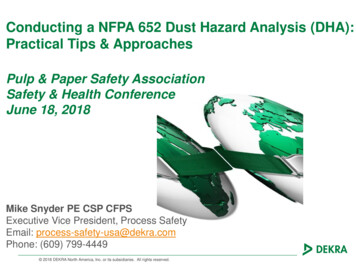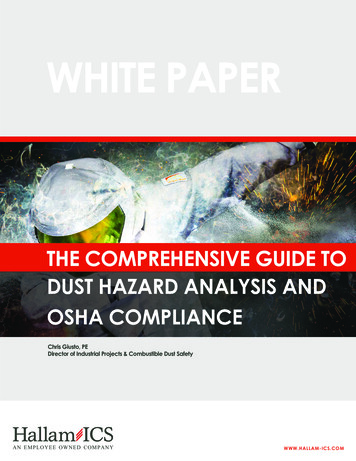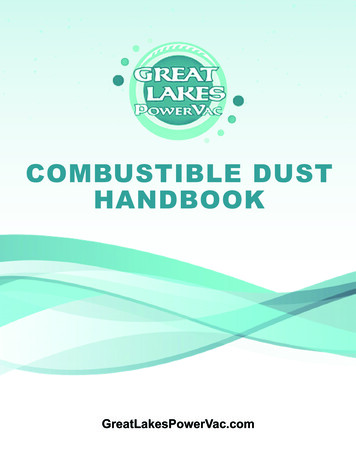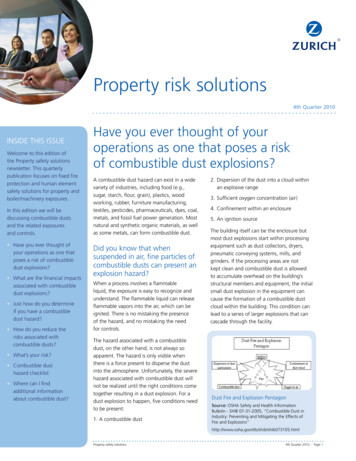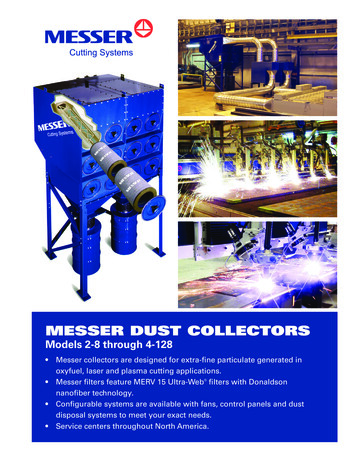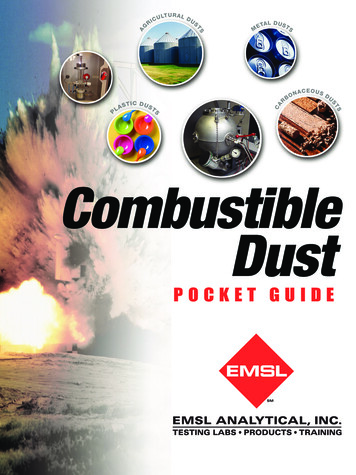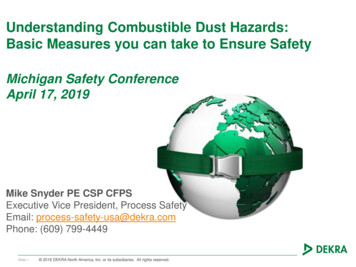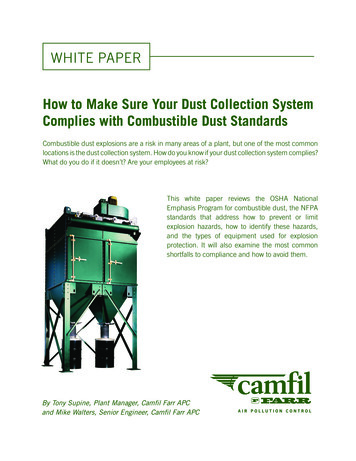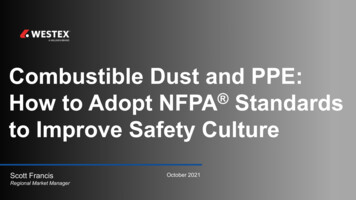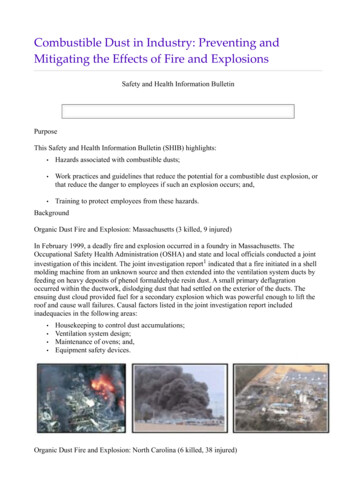
Transcription
Combustible Dust in Industry: Preventing andMitigating the Effects of Fire and ExplosionsSafety and Health Information BulletinPurposeThis Safety and Health Information Bulletin (SHIB) highlights: Hazards associated with combustible dusts; Work practices and guidelines that reduce the potential for a combustible dust explosion, orthat reduce the danger to employees if such an explosion occurs; and, Training to protect employees from these hazards.BackgroundOrganic Dust Fire and Explosion: Massachusetts (3 killed, 9 injured)In February 1999, a deadly fire and explosion occurred in a foundry in Massachusetts. TheOccupational Safety Health Administration (OSHA) and state and local officials conducted a jointinvestigation of this incident. The joint investigation report1 indicated that a fire initiated in a shellmolding machine from an unknown source and then extended into the ventilation system ducts byfeeding on heavy deposits of phenol formaldehyde resin dust. A small primary deflagrationoccurred within the ductwork, dislodging dust that had settled on the exterior of the ducts. Theensuing dust cloud provided fuel for a secondary explosion which was powerful enough to lift theroof and cause wall failures. Causal factors listed in the joint investigation report includedinadequacies in the following areas: Housekeeping to control dust accumulations;Ventilation system design;Maintenance of ovens; and,Equipment safety devices.Organic Dust Fire and Explosion: North Carolina (6 killed, 38 injured)
In January 2003, devastating fires and explosions destroyed a North Carolina pharmaceutical plantthat manufactured rubber drug-delivery components. Six employees were killed and 38 people,including two firefighters, were injured. The U.S. Chemical Safety and Hazard Investigation Board(CSB), an independent Federal agency charged with investigating chemical incidents, issued a finalreport2 concluding that an accumulation of a combustible polyethylene dust above the suspendedceilings fueled the explosion. The CSB was unable to determine what ignited the initial fire or howthe dust was dispersed to create the explosive cloud in the hidden ceiling space. The explosionseverely damaged the plant and caused minor damage to nearby businesses, a home, and a school.The causes of the incident cited by CSB included inadequacies in: Hazard assessment;Hazard communication; andEngineering management.The CSB recommended the application of provisions in National Fire Protection Associationstandard NFPA 654, Standard for the Prevention of Fire and Dust Explosions from theManufacturing, Processing, and Handling of Combustible Particulate Solids, as well as the formaladoption of this standard by the State of North Carolina.Organic Dust Fire and Explosion: Kentucky (7 killed, 37 injured)In February 2003, a Kentucky acoustics insulation manufacturing plant was the site of another fataldust explosion. The CSB also investigated this incident. Their report3 cited the likely ignitionscenario as a small fire extending from an unattended oven which ignited a dust cloud created bynearby line cleaning. This was followed by a deadly cascade of dust explosions throughout theplant. The CSB identified several causes of ineffective dust control and explosionprevention/mitigation involving inadequacies in: Hazard assessment;Hazard communication;Maintenance procedures;Building design; and,Investigation of previous fires.Metal Dust Fire and Explosion: Indiana (1 killed, 1 injured)Finely dispersed airborne metallic dust can also be explosive when confined in a vessel or building.In October 2003, an Indiana plant where auto wheels were machined experienced an incident whichwas also investigated by the CSB. A report has not yet been issued, however, a CSB news release4told a story similar to the previously discussed organic dust incidents: aluminum dust was involvedin a primary explosion near a chip melting furnace, followed by a secondary blast in dust collectionequipment.Related Experience in the Grain Handling IndustryIn the late 1970s a series of devastating grain dust explosions in grain elevators left 59 people deadand49 injured. In response to these catastrophic events, OSHA issued a "Grain Elevator IndustryHazard Alert" to provide employers, employees, and other officials with information on the safetyand health hazards associated with the storage and distribution of grain.In 1987, OSHA promulgated the Grain Handling Facilities standard (29 CFR 1910.272), whichremains in effect. This standard, other OSHA standards such as Emergency Action Plans (29 CFR1910.38), and updated industry consensus standards all played an important role in reducing the
occurrence of explosions in this industry, as well as mitigating their effects. The lessons learned inthe grain industry can be applied to other industries producing, generating, or using combustibledust.Elements of a Dust ExplosionElements Needed for a Fire (the familiar "Fire Triangle"):1. Combustible dust (fuel);2. Ignition source (heat); and,3. Oxygen in air (oxidizer).Additional Elements Needed for a Combustible Dust Explosion:4. Dispersion of dust particles in sufficient quantity and concentration; and,5. Confinement of the dust cloud.The addition of the latter two elements to the fire triangle creates what is known as the "explosionpentagon" (see Figure 1). If a dust cloud (diffused fuel) is ignited within a confined or semiconfined vessel, area, or building, it burns very rapidly and may explode. The safety of employeesis threatened by the ensuing fires, additional explosions, flying debris, and collapsing buildingcomponents.An initial (primary) explosion (see Figure 2) in processing equipment or in an area were fugitivedust has accumulated may shake loose more accumulated dust, or damage a containment system(such as a duct, vessel, or collector). As a result, if ignited, the additional dust dispersed into the airmay cause one or more secondary explosions (see Figure 2). These can be far more destructive than
a primary explosion due to the increased quantity and concentration of dispersed combustible dust.If one of the elements of the explosion pentagon is missing, a catastrophic explosion can not occur.Two of the elements in the explosion pentagon are difficult to eliminate: oxygen (within air), andconfinement of the dust cloud (within processes or buildings). However, the other three elements ofthe pentagon can be controlled to a significant extent, and will be discussed further in thisdocument.Facility Dust Hazard AssessmentA combustible dust explosion hazard may exist in a variety of industries, including: food (e.g.,candy, starch, flour, feed), plastics, wood, rubber, furniture, textiles, pesticides, pharmaceuticals,dyes, coal, metals (e.g., aluminum, chromium, iron, magnesium, and zinc), and fossil fuel powergeneration. The vast majority of natural and synthetic organic materials, as well as some metals, canform combustible dust. NFPA’s Industrial Fire Hazards Handbook5states that "any industrial process that reduces a combustible material and some normallynoncombustible materials to a finely divided state presents a potential for a serious fire orexplosion."Facility Analysis ComponentsFacilities should carefully identify the following in order to assess their potential for dustexplosions: Materials that can be combustible when finely divided;Processes which use, consume, or produce combustible dusts;Open areas where combustible dusts may build up;Hidden areas where combustible dusts may accumulate;Means by which dust may be dispersed in the air; andPotential ignition sources.
The applicable Federal, state, and local laws and regulations must be identified and followed. Thetwo predominant model fire codes which have been adopted by many jurisdictions in this countryare the International Code Council’s International Fire Code and NFPA’s Uniform Fire Code .Both of these model codes reference many of the NFPA consensus standards related to dustexplosion prevention and mitigation which are discussed below. In the absence of a legal mandateto comply with these consensus standards, they should be considered a very useful source ofguidance on this topic.Dust CombustibilityThe primary factor in an assessment of these hazards is whether the dust is in fact combustible. Any"material that will burn in air" in a solid form can be explosive when in a finely divided form.6Combustible dust is defined by NFPA 654 as: "Any finely divided solid material that is 420 micronsor smaller in diameter (material passing a U.S. No. 40 Standard Sieve) and presents a fire orexplosion hazard when dispersed and ignited in air." The same definition is used for combustiblemetal dust in NFPA 484, Standard for Combustible Metals, Metal Powders, and Metal Dusts. Onepossible source for information on combustibility is the Material Safety Data Sheet (MSDS) for thematerial. In some cases, additional information such as test results will be available from chemicalmanufacturers.Different dusts of the same chemical material will have different ignitability and explosibilitycharacteristics, depending upon many variables such as particle size, shape, and moisture content.Additionally, these variables can change while the material is passing through process equipment.For this reason, published tables of dust explosibility data may be of limited practical value. Insome cases, dusts will be combustible even if the particle size is larger than that specified in theNFPA definition, especially if the material is fibrous.7Industrial settings may contain high-energy ignition sources such as welding torches. In thesesituations, test methods for dust ignition and explosion characteristics from ASTM International(originally the American Society for Testing and Materials) would be of value. A discussion of thesetest methods is in reference 8, and the relevant OSHA and other standards are listed in the "Sourcesof Additional Information" section of this document.Electrical ClassificationThe facility analysis must identify areas requiring special electrical equipment classification due tothe presence (or potential presence) of combustible dust. The OSHA Electrical standard (29 CFRPart 1910Subpart S) contains general requirements for electrical installations in hazardous areas. Detailedrequirements for equipment and wiring methods are in NFPA 70, the National Electrical Code .However, NFPA 70 does not define combustible dusts.Further guidance on area classification is contained in NFPA 499, Recommended Practice for theClassification of Combustible Dusts and of Hazardous (classified) Locations for ElectricalInstallations in Chemical Process Areas. This document uses the same definition of combustibledust as NFPA 484 and NFPA 654. The overall dust hazard designation for electrical requirements isClass II. This is further broken down into Divisions which represent the probability of dust beingpresent at any given time. Additionally, each dust is assigned a group (E, F, or G), representing thedust types (metal, carbonaceous, and other, respectively) with different properties. For instance,group E dusts are electrically conductive and electric current can pass through a layer of such dustunder favorable circumstances, causing short circuits or arcs.
Other Hazard Analysis ConsiderationsThe amount of dust accumulation necessary to cause an explosive concentration can vary greatly.This is because there are so many variables – the particle size of the dust, the method of dispersion,ventilation system modes, air currents, physical barriers, and the volume of the area in which thedust cloud exists or may exist. As a result, simple rules of thumb regarding accumulation (such aswriting in the dust or visibility in a dust cloud) can be subjective and misleading. The hazardanalysis should be tailored to the specific circumstances in each facility and the full range ofvariables affecting the hazard.Many locations need to be considered in an assessment. One obvious place for a dust explosion toinitiate is where dust is concentrated. In equipment such as dust collectors, a combustible mixturecould be present whenever the equipment is operating. Other locations to consider are those wheredust can settle, both in occupied areas and in hidden concealed spaces. A thorough analysis willconsider all possible scenarios in which dust can be disbursed, both in the normal process andpotential failure modes.After hazards have been assessed and hazardous locations are identified, one or more of thefollowing prevention, protection and/or mitigation methods may be applied. The references andinformation sources at the end of this document will assist in the decision process for the methodssuitable to specific work sites. Additional guidance and requirements may be available from local orstate fire and building code officials as well as OSHA Area or Regional Offices.Dust ControlNFPA 654, Standard for the Prevention of Fire and Dust Explosions from the Manufacturing,Processing, and Handling of Combustible Particulate Solids, contains comprehensive guidance onthe control of dusts to prevent explosions. The following are some of its recommendations: Minimize the escape of dust from process equipment or ventilation systems;Use dust collection systems and filters;Utilize surfaces that minimize dust accumulation and facilitate cleaning;Provide access to all hidden areas to permit inspection;Inspect for dust residues in open and hidden areas, at regular intervals;Clean dust residues at regular intervals;Use cleaning methods that do not generate dust clouds, if ignition sources are present;Only use vacuum cleaners approved for dust collection;Locate relief valves away from dust hazard areas; andDevelop and implement a hazardous dust inspection, testing, housekeeping, and controlprogram (preferably in writing with established frequency and methods).The OSHA ventilation standard, 29 CFR 1910.94, contains ventilation requirements for certaintypes of operations (such as abrasives, blasting, grinding, or buffing) which involve dusts, includingcombustible dusts. Additionally, 29 CFR 1910.22(a)(1) requires employers to keep work places andother areas clean, which includes the removal of dust accumulations.Ignition ControlNFPA 654, Standard for the Prevention of Fire and Dust Explosions from the Manufacturing,Processing, and Handling of Combustible Particulate Solids, also contains comprehensive guidanceon the control of ignition sources to prevent explosions. The following are some of itsrecommendations: Use appropriate electrical equipment and wiring methods;
Control static electricity, including bonding of equipment to ground;Control smoking, open flames, and sparks;Control mechanical sparks and friction;Use separator devices to remove foreign materials capable of igniting combustibles fromprocess materials;Separate heated surfaces from dusts;Separate heating systems from dusts;Proper use and type of industrial trucks;Proper use of cartridge activated tools; andAdequately maintain all the above equipment.The use of proper electrical equipment in hazardous locations is crucial to eliminating a commonignition source. The classification of areas requiring special electrical equipment is discussed in theFacility Dust Hazard Assessment section above. Once these areas have been identified, specialClass II wiring methods and equipment (such as "dust ignition-proof" and "dust-tight") must beused as required by 29 CFR 1910.307 and as detailed in NFPA 70 Article 500. It is important not toconfuse Class II equipment with Class I explosion-proof equipment, as Class II addresses dusthazards, while Class I addresses gas, vapor and liquid hazards.The use of industrial trucks is regulated by OSHA’s Powered Industrial Trucks standard (29 CFR1910.178). Hazardous atmospheres including dust concentrations are addressed in paragraph (c) ofthis standard.Where coal-handling operations may produce a combustible atmosphere from flammable dust,employers covered by the Electric Power Generation, Transmission, and Distribution standard musteliminate or safely control ignition sources. See 29 CFR 1910.269(v)(11)(xii).Damage ControlNFPA 654, Standard for the Prevention of Fire and Dust Explosions from the Manufacturing,Processing, and Handling of Combustible Particulate Solids, contains comprehensive guidance tominimize the danger and damage from an explosion. The following are some suggested protectionmethods: Separation of the hazard (isolate with distance);Segregation of the hazard (isolate with a barrier);Deflagration venting of a building, room, or area;Pressure relief venting for equipment;Provision of spark/ember detection and extinguishing systems;Explosion protection systems (also refer to NFPA 69, Standard on Explosion PreventionSystems);Sprinkler systems; andThe use of other specialized suppression systems.TrainingEmployeesWorkers are the first line of defense in preventing and mitigating fires and explosions. If the peopleclosest to the source of the hazard are trained to recognize and prevent hazards associated withcombustible dust in the plant, they can be instrumental in recognizing unsafe conditions, takingpreventative action, and/or alerting management. While OSHA standards require training for certainemployees, all employees should be trained in safe work practices applicable to their job tasks, aswell as on the overall plant programs for dust control and ignition source control. They should be
trained before they start work, periodically to refresh their knowledge, when reassigned, and whenhazards or processes change.Employers with hazardous chemicals (including combustible dusts) in their workplaces are requiredto comply with 29 CFR 1910.1200, the Hazard Communication standard. This includes havinglabels on containers of hazardous chemicals, using material safety data sheets, and providingemployee training.ManagementA qualified team of managers should be responsible for conducting a facility analysis (or for havingone done by qualified outside persons) prior to the introduction of a hazard and for developing aprevention and protection scheme tailored to their operation. Supervisors and managers should beaware of and support the plant dust and ignition control programs. Their training should includeidentifying how they can encourage the reporting of unsafe practices and facilitate abatementactions.References1. Occupational Safety and Health Administration (OSHA), the Massachusetts Office of the StateFireMarshall, and the Springfield Arson and Bomb Squad. "Joint Foundry Explosion InvestigationTeam Report." OSHA, Springfield, MA, (No date).2. Chemical Safety and Hazard Investigation Board (CSB). "Investigation Report: WestPharmaceutical Services, Inc. Dust Explosion." CSB, Washington, DC, September 2004.3. Chemical Safety and Hazard Investigation Board (CSB). "Investigation Report: CTAAcoustics,Inc. Combustible Dust Fire and Explosions." CSB, Washington, DC, September 2004.4. Chemical Safety and Hazard Investigation Board (CSB). "CSB Investigators Find Likely Sourceof Dust Explosion at Indiana Automotive Plant." CSB News Release, Washington, DC, November5, 2003.5. National Fire Protection Association (NFPA). "Industrial Fire Hazards Handbook," 3rd Edition.NFPA, Inc., Quincy, MA, 1990.6. Cross, J., and Farrer, D., "Dust Explosions," New York: Plenum Press, 1982.7. Cashdollar, K.L., "Overview of Dust Explosibility Characteristics," Journal of Loss Prevention inthe Process Industries, v. 13, pp. 183-199, 2000.8. Britton, L.G., Cashdollar, K.L, Fenlon, W., Frurip, D., Going, J., Harrison, B.K., Niemeier, J.,and Ural, E.A., "The Role of ASTM E27 Methods in Hazard Assessment Part II: Flammability andIgnitability," Process Safety Progress, v. 24, pp. 12-28, 2005.General InformationFM Global, "Prevention and Mitigation of Combustible Dust Explosions and Fire", Data Sheet No.7-76, January 2005.
Eckhoff, Rolf K. "Dust Explosions in the ProcessIndustries," 3rd Edition, Gulf ProfessionalPublishing, 2003.Bartknecht, W. "Dust Explosions: Course, Prevention, and Protection," Springer- Verlag, 1989.Hatwig, M., and Steen, H. (eds.), "Handbook of Explosion Prevention and Protection," Wiley-VCH,2004.Frank, Walter. "Dust Explosion Prevention and the Critical Importance of Housekeeping," ProcessSafety Progress, vol. 23, no. 3, September 2004, pp. 175-184.Amyotte, P., Kahn, F., and Dastidar, A. "Reduce Dust Explosions the Inherently Safer Way,"Chemical Engineering Progress, vol. 99, no. 10, October 2003, pp. 36-43.Ebidat, Vahid. "Is Your Dust Collection System an Explosion Hazard?" Chemical EngineeringProgress, vol. 99, no. 10, October 2003, pp. 44-49.Center for Chemical Process Safety (CCPS). "Guidelines for Safe Handling of Powders and BulkSolids." CCPS, American Institute for Chemical Process Safety, New York, New York, January2005.Sources of Additional InformationNote: This SHIB was developed using the latest information and requirements from the referencesbelow. Editions are not listed here, since users of this document should refer to the most currenteditions.Code of Federal Regulations (CFR) [Standards]U.S. Government Printing Office732 N. Capitol Street, NW Washington, DC 20401Telephone: 1-866-512-1800 (toll-free)OSHA Standards, Interpretations, and PublicationsU.S. Department of Labor/OSHA OSHA Publications Office200 Constitution Ave., NW, N-3101Washington, DC 20210Telephone: (202) 693-1888or by Fax: (202) 693-2498Related OSHA standards found in 29 CFR:1910.22 - General Requirements: Housekeeping·1910.38 - Emergency Action Plans1910.94 - Ventilation1910.107 - Spray Finishing Using Flammable and Combustible Materials1910.146 - Permit-Required Confined Spaces (references combustible dust)1910.178 - Powered Industrial Trucks1910.269 - Electric Power Generation, Transmission and Distribution (coal handling)1910.272 - Grain Handling Facilities1910.307 - Hazardous (classified) Locations (for electric equipment)
1910.1200 - Hazard CommunicationU.S. Chemical Safety and Hazard Investigation Board2175 K Street, NW, Suite 400Washington, DC 20037-1809Telephone: (202) 261-7600Fax: (202) 261-7650ASTM International100 Barr Harbor DriveP. O. Box C700West Conshohocken, PA 19428-2959Telephone: (610) 832-9585Fax: (610) 832-955Related ASTM Standards: E789-95 Standard Test Method for Dust Explosions in a 1.2-Litre Closed Cylindrical VesselE1226-00e1 Standard Test Method for Pressure and Rate of Pressure Rise for CombustibleDustsE1491-97 Standard Test Method for Minimum Autoignition Temperature of Dust CloudsE1515-03a Standard Test Method for Minimum Explosible Concentration of CombustibleDustsE2021-01 Standard Test Method for Hot- Surface Ignition Temperature of Dust LayersNational Materials Advisory Board (NMAB) PublicationsNational Academies Press500 Fifth St., NW Washington, DC 20001Telephone: (202) 334-3313Fax: (202) 334-2451Related NMAB Publication: NMAB 353-4 (1982), Classification of Dusts Relative to Electrical Equipment in Class IIHazardous Locations.National Fire Protection Association (NFPA)1 Batterymarch ParkQuincy, MA 02169-7471Telephone: (800) 344-3555Related NFPA Standards: NFPA 61, Standard for the Prevention of Fires and Dust Explosions in Agricultural and FoodProcessing FacilitiesNFPA 68, Guide for Venting of DeflagrationsNFPA 69, Standard on Explosion Prevention SystemsNFPA 70, National Electrical Code NFPA 91, Standard for Exhaust Systems for Air Conveying of Vapors, Gases, Mists, andNoncombustible Particulate Solids
NFPA 120, Standard for Fire Prevention and Control in Metal/Nonmetal Mining and MetalMineral Processing FacilitiesNFPA 432, Code for the Storage of Organic Peroxide FormulationsNFPA 480, Standard for the Storage, Handling, and Processing of Magnesium Solids andPowdersNFPA 481, Standard for the Production, Processing, Handling, and Storage of TitaniumNFPA 482, Standard for the Production, Processing, Handling, and Storage of ZirconiumNFPA 484, Standard for Combustible Metals, Metal Powders, and Metal DustsNFPA 485, Standard for the Storage, Handling, Processing, and Use of Lithium MetalNFPA 495, Explosive Materials CodeNFPA 499, Recommended Practice for the Classification of Combustible Dusts and ofHazardous (Classified) Locations for Electrical Installations in Chemical Process AreasNFPA 505, Fire Safety Standard for Powered Industrial Trucks Including Type Designations,Areas of Use, Conversions, Maintenance, and OperationNFPA 560, Standard for the Storage, Handling, and Use of Ethylene Oxide for Sterilizationand FumigatNFPA 654, Standard for the Prevention of Fire and Dust Explosions from theManufacturing, Processing, and Handling of Combustible Particulate SolidsNFPA 655, Standard for Prevention of Sulfur Fires and ExplosionsNFPA 664, Standard for the Prevention of Fires and Explosions in Wood Processing andWoodworking FacilitiesNFPA 1124, Code for the Manufacture, Transportation, Storage, and Retail Sales ofFireworks and Pyrotechnic ArticlesNFPA 1125, Code for the Manufacture of Model Rocket and High Power Rocket Motors
the grain industry can be applied to other industries producing, generating, or using combustible dust. Elements of a Dust Explosion Elements Needed for a Fire (the familiar "Fire Triangle"): 1. Combustible dust (fuel); 2. Ignition source (heat); and, 3. Oxygen in air (oxidizer). Additional Elements Needed for a Combustible Dust Explosion: 4.

